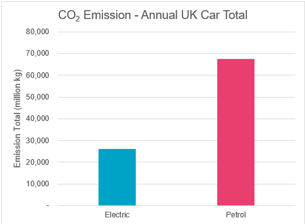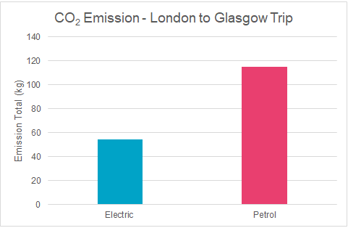Emission
accomplished? Putting an Electric Vehicle to the test
Our viewpoint
30 May 2019
A recent trip up to Glasgow turned out to be an ideal opportunity for LCP’s Head of Market Insight, Kyle Martin and Energy UK’s Director of Economics & Corporate Affairs, Sam Hollister to put an Electric Vehicle through its paces. Here’s what they made of it…
A couple of months ago, the two of us were discussing the best way to get to the All Energy conference in Glasgow. To be honest, we didn’t take the initial suggestion that we made the journey by Electric Vehicle (EV) too seriously. Surely it would be too hard and take too long? But at the same time, we have been enthusiastic advocates of the rollout for some time so shouldn’t we take the chance to discover the current reality for EV drivers?
So after doing some research about the journey and with the timely publication of the Committee on Climate Change’s net zero report (with the rollout of EVs playing a vital role) acting as an extra incentive - plus Nissan agreeing to lend us an EV - the trip was on. We would drive the 425 miles from London to Glasgow in an EV.
The Nissan Leaf has a 40Kwh battery with a range of 168 miles when fully charged. Taking into consideration the stops needed to re-charge the car, we estimated that the journey would take around 10 hours. But this turned out to be closer to 17 hours.
Those extra hours provided the two of us with ample opportunity to reflect on what changes will be required before the mass roll out of EVs becomes a reality in the UK.
It is about the car
EVs certainly have many advantages over petrol or diesel vehicles. Waking up in the morning with a fully charged battery without having to stop at a filling station certainly has its appeal. The reduction in noise pollution is amazing although not without its hazards - in the absence of the usual engine sound, it’s quite easy to nearly get run over by your travelling companion when your stretching you're legs at a pit stop.
Things started well, covering 250 miles in six hours with two successful stops resulting in nearly full batteries after 45-minute charges.
We did find that travelling above 55 MPH really reduces your range, which means that if you want to get the most out of your battery you need to drive at a reduced speed. The other big issue we found was with battery temperature. After our second stop, it started to overheat and all subsequent attempts to charge the car resulted in only 30-40 miles worth of charge being added each time. Reflect on that for a moment – charge for 45 minutes on a rapid charger and you only get 20 minutes of driving time before you must charge again. There seems to be two reasons for this: the battery can’t be repeatedly rapid charged – it loses efficiency and overheats, and secondly, not all chargers seem to deliver what is advertised. Despite the name, rapid chargers don’t always charge your car rapidly.
Charging ahead
During the drive up to Glasgow and back, we charged the car a total of 10 times and had a range of experiences.
Charging apps ranged from great to terrible and we ended up having to download several apps. Whilst a single app would certainly make life simpler, we didn’t consider dealing with several to be a particular issue. If you think about it, we already use multiple apps in our daily lives and we cope just fine. If there is a solution out there to remove the need for multiple apps then we would welcome it, but at the same time it won’t stop either of us buying an EV - having experienced 5 different charging networks during one return journey.
Finding somewhere to charge wasn’t a problem while on the motorway as most service stations had chargers installed. However, once off the motorway, we really needed the second pair of eyes provided by having a passenger to search through the different charging apps and find the right power rating and connector type. You then have to hope that the one you do find works. We only found one that wasn’t - but at the that point we only had charge left for 10 miles. Thankfully we did then find a functioning charger but with only 2% battery and zero mile range left at that point, it was not good for our collective blood pressure….
A definite concern that each service station had, on average, just two chargers (not counting Tesla chargers). Clearly if we expect EV take-up to really gather momentum over the next few years, we need to build more chargers.
Driving Lessons
If your stop is planned around breakfast, lunch or dinner, then the 45 minute wait to charge your car doesn’t have to be tedious. Otherwise your options are limited, encompassing either a walk around the carpark or venturing into the dreary gambling area seemingly found in most service stations.
More worrying are the potential safety concerns that could arise whilst charging. On one occasion we pulled into a local car park outside Glasgow where the EV charging station was occupied by a lone female in a Nissan Leaf. We got talking about life as an EV driver - she was a convert and having heard about our epic journey, offered to unplug and allow us to charge instead, thus demonstrating the solidarity amongst drivers that is a feature of the EV revolution. We did reflect that charging your EV at night alone in a quiet car park might leave you feeling a little unsafe and agreed that there is room for improvement on this score.
So, our 5 key lessons from our trip on how best to enable the rollout of EV’s are:
- EVs need to give drivers the same - or a better - driving experience than petrol/diesel equivalents, including speed and range. Battery technology needs to improve to cope with multiple rapid charges. Drivers shouldn’t have to be constrained by battery performance.
- Rapid charging infrastructure needs to be consistent both in terms of connector type and the power rating (speed of charge). A nationwide roll out of rapid charging infrastructure needs to be built in anticipation of mass take-up in order to meet future demand.
- The apps used to operate rapid chargers need to be improved with an emphasis on providing an effective user interface.
- Location and availability of chargers needs to be built into a single app or cars’ SatNav so a lone driver can find chargers easily.
- We need to think about the charging experience as well as the driving one. Recharging locations will need to cater for longer stops and have safety concerns in mind - so EV chargers in local car parks should be in well-lit areas.
There is no doubt that EVs are the future - especially once prices come down. Most people could purchase an EV today that would suit most of their needs and give them a superior experience. While we’ve highlighted issues here that show we still have some way to go, these are easily overcome and won’t stand in the way of mass EV adoption in the long term - if Government and industry work together to deliver it.
Emission accomplished
Finally, given what underpins the entire EV rollout, it seems apt to look at the CO2 emissions used for this trip. The electricity used to power our EV produced 54Kg/CO2 - while a petrol equivalent would have produced 115Kg/CO2. So even though the journey in the EV took a bit longer, the amount of carbon used was less than half of that used by a petrol car. As the graph below illustrates, if everyone in the UK used an EV today we could save 416 million tonnes of CO2 per annum. And importantly, those figures will continue to improve as we further decarbonise our power sector.



